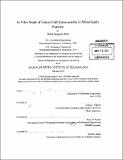In vitro study of cancer cell extravasation in microfluidic platform
Author(s)
Jeon, Jessie Sungyun
DownloadFull printable version (14.87Mb)
Other Contributors
Massachusetts Institute of Technology. Department of Mechanical Engineering.
Advisor
Joseph L. Charest and Roger D. Kamm.
Terms of use
Metadata
Show full item recordAbstract
Cancer metastases arise from the cancer cells that disseminate from the primary tumor, intravasate into the vascular system and eventually transmigrate across the endothelium into to a secondary site through a process of extravasation. Microfluidic systems have a major advantage in studying cancer extravasation since they can mimic aspects of the 3D in vivo situation in a controlled environment while simultaneously providing in situ imaging capabilities for visualization, thereby enabling quantification of cell-cell and cell-matrix interactions. Moreover, microfluidics enable parametric study of multiple factors in controlled and repeatable conditions. This thesis describes novel 3D microfluidic models to mimic the tumor microenvironment and vasculature during cancer cell extravasation in order to investigate the critical steps of extravasation. First, a general non-organ-specific cancer cell extravasation model is developed in which the endothelial cells that cover the walls of the microfluidic channel represent the vessel endothelium, and the entire extravasation process including tumor cell adhesion to the endothelium and subsequent transmigration can be observed. A second model is then introduced to mimic organ-specific extravasation and investigate the preference of certain types of cancer to target specific organs for metastass. The improved model was used to study the specificity of human breast cancer metastases to bone, by recreating a vascularized bone-mimicking microenvironment. The tri-culture system allowed us to study the transendothelial migration of highly metastatic breast cancer cells and to monitor their behavior within the bone-like matrix. Next, functional microvascular networks were generated in the microfluidic system through vasculogenesis with addition of mural cells and pro-angiogenic factors to better replicate the normal physiological vasculature of the remote site for metastasis. Lastly, the vasculogenesis approach was combined with the bone-mimicking model to develop a functional osteo-cell conditioned vasculature model to study physiologically relevant extravasation in a bone-like microenvironment. In addition to the quantification of extravasation rates and subsequent tumor cell migration into the model tissue, the vascular networks were characterized by measuring permeability, and immunostaining of proteins secreted by osteo-cell and mural cell markers confirmed the creation of microenvironments and the presence of multiple cell types within the matrix. This study provides novel 3D in vitro quantitative data on cancer cell extravasation and micrometastasis of breast cancer cells within a bone-mimicking microenvironment. The developed microfluidic system represents an advanced in vitro model to study complex biological phenomena such as extravasation involving functional microvascular networks under organ-specific conditions and demonstrates the potential value of microfluidic technologies to better understand cancer biology and screen for new therapeutics.
Description
Thesis: Ph. D., Massachusetts Institute of Technology, Department of Mechanical Engineering, 2014. Cataloged from PDF version of thesis. Includes bibliographical references.
Date issued
2014Department
Massachusetts Institute of Technology. Department of Mechanical EngineeringPublisher
Massachusetts Institute of Technology
Keywords
Mechanical Engineering.